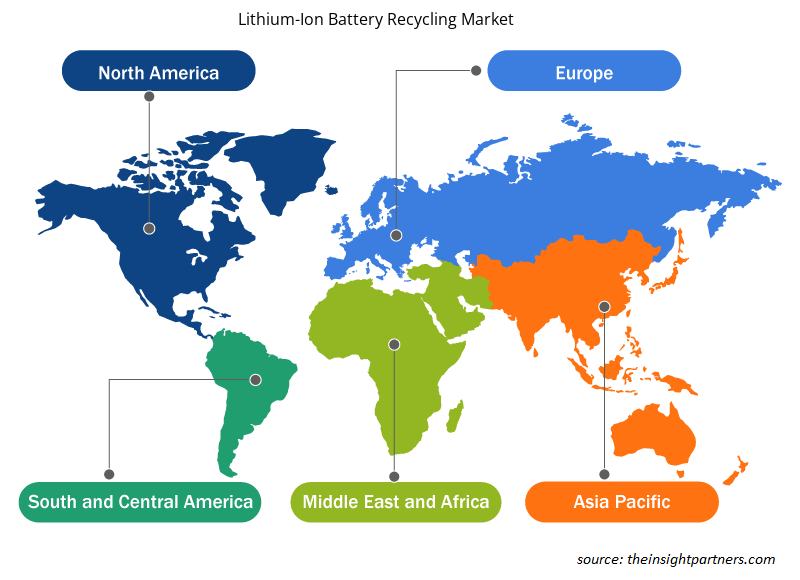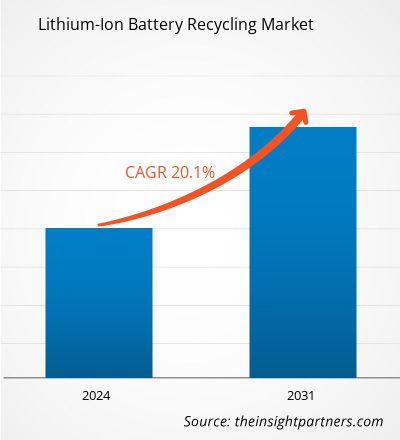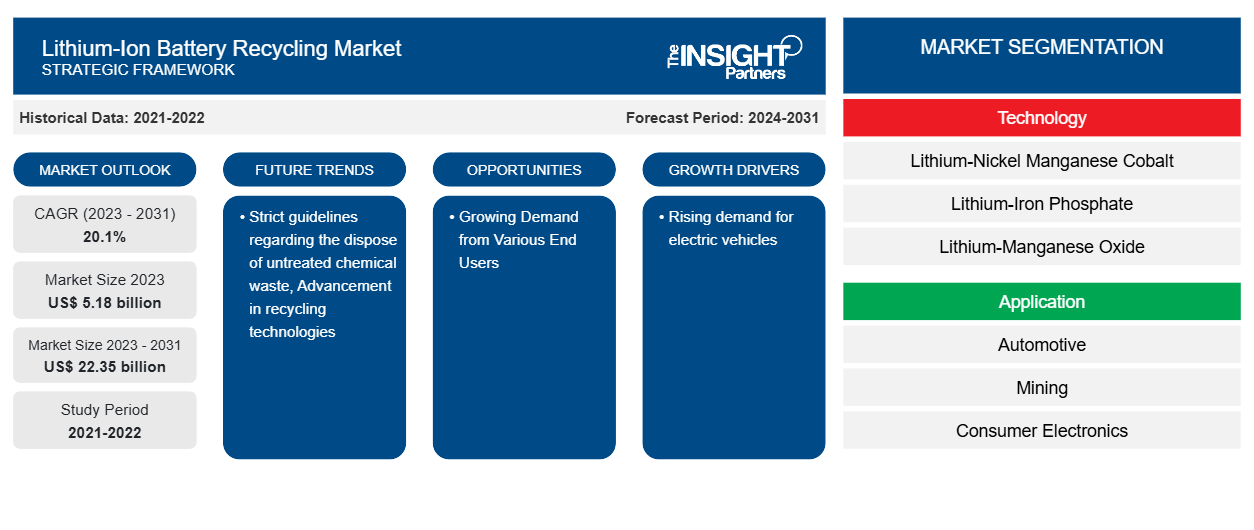من المتوقع أن ينمو حجم سوق إعادة تدوير بطاريات الليثيوم أيون من 5.18 مليار دولار أمريكي في عام 2023 إلى 22.35 مليار دولار أمريكي بحلول عام 2031؛ ومن المتوقع أن ينمو بمعدل نمو سنوي مركب قدره 20.1٪ من عام 2023 إلى عام 2031. ومن المرجح أن تظل المبادئ التوجيهية الصارمة فيما يتعلق بالتخلص من النفايات الكيميائية غير المعالجة والتقدم في تقنيات إعادة التدوير من الاتجاهات الرئيسية في سوق إعادة تدوير بطاريات الليثيوم أيون.
تحليل سوق إعادة تدوير بطاريات الليثيوم أيون
شهد قطاع السيارات زيادة هائلة في الطلب على بطاريات الليثيوم أيون المعاد تدويرها في السنوات الأخيرة، وخاصة في الولايات المتحدة وألمانيا والسويد والنرويج وهولندا والصين، وكذلك في عدد قليل من دول جنوب شرق آسيا النامية. وتشير تقارير وكالة الطاقة الدولية إلى أنه مقارنة بعام 2020، تضاعفت مبيعات السيارات الكهربائية تقريبًا إلى 6.6 مليون (أو ما يقرب من 9٪) في عام 2021، مع وجود 16.5 مليون سيارة كهربائية على الطريق بشكل عام. وعلاوة على ذلك، تتوقع وكالة الطاقة الدولية أنه بحلول عام 2030، سيكون هناك أكثر من 300 مليون سيارة كهربائية على الطريق، مما سيؤدي على الأرجح إلى زيادة إعادة تدوير بطاريات الليثيوم أيون. ومن المتوقع في الأساس أن يؤدي تزايد معرفة المستهلكين بالتأثيرات البيئية الإيجابية للسيارات الكهربائية في الدول النامية في المنطقة إلى تحفيز نمو الصناعة. ويركز المصنعون على إعادة تدوير بطاريات الليثيوم أيون المستهلكة من أجل تلبية الطلب عليها في السيارات.
نظرة عامة على سوق إعادة تدوير بطاريات الليثيوم أيون
بطارية الليثيوم أيون (LIB) هي نوع من الخلايا الكهروكيميائية التي تحتوي على مكونات مثل الأقطاب الكهربائية والحفازات لدعم توليد الطاقة لمجموعة متنوعة من التطبيقات. تحتوي أنابيب الكاثود والأنود على مجموعة متنوعة من المعادن الثمينة ذات الاحتياطيات المحدودة وأسعار إعادة البيع المرتفعة. ونتيجة لذلك، يتم استخدام عملية إعادة تدوير بطاريات الليثيوم أيون لاستعادة وبيع المواد الخام التي تم جمعها في تركيبة الأقطاب الكهربائية، مما يقلل من التكلفة الإجمالية للمشروع والتأثير. ستساعد هذه الأسباب في نمو سوق إعادة تدوير بطاريات الليثيوم أيون
وقد أثار الاستخدام المتزايد لبطاريات الليثيوم أيون في مجموعة متنوعة من التطبيقات مخاوف بشأن تقييد إمدادات المعدن الأساسي. إن تعدين هذا المعدن له تأثير سلبي على البيئة، بما في ذلك تلوث المياه الناجم عن التسرب الكيميائي. ونتيجة لذلك، زادت إعادة تدوير بطاريات الليثيوم أيون مؤخرًا. وعلاوة على ذلك، نظرًا لعدم وجود مادة أخرى تقدم حاليًا خصائص مماثلة لليثيوم، فإن منتجي البطاريات يركزون بشكل متزايد على إعادة استخدام بطاريات الليثيوم لتوفير كمية مناسبة من المعدن للبطاريات لاستخدامات مختلفة. وفي هذا الصدد، أعلنت شركة الكيماويات الألمانية BASF في يونيو 2021 عن خطط لبدء بناء مصنع جديد لإعادة تدوير البطاريات وإنتاج النماذج الأولية في منشأة المواد النشطة للكاثود (CAM) في شوارزهايد. عندما تصل بطاريات الليثيوم أيون إلى نهاية عمرها الإنتاجي، تعتزم الشركة استخراج الكوبالت والمنجنيز والليثيوم والنيكل باستخدام طريقة محسنة.
قم بتخصيص هذا التقرير ليناسب متطلباتك
ستحصل على تخصيص لأي تقرير - مجانًا - بما في ذلك أجزاء من هذا التقرير، أو تحليل على مستوى الدولة، وحزمة بيانات Excel، بالإضافة إلى الاستفادة من العروض والخصومات الرائعة للشركات الناشئة والجامعات
-
احصل على أهم اتجاهات السوق الرئيسية لهذا التقرير.ستتضمن هذه العينة المجانية تحليلاً للبيانات، بدءًا من اتجاهات السوق وحتى التقديرات والتوقعات.
محركات وفرص سوق إعادة تدوير بطاريات الليثيوم أيون
ارتفاع الطلب على المركبات الكهربائية يعزز نمو السوق
إن الشعبية المتزايدة للسيارات الكهربائية هي أحد العوامل الرئيسية التي تدفع سوق إعادة تدوير بطاريات الليثيوم أيون. ومع زيادة حجم السيارات الكهربائية المصنعة والمباعة، أصبحت الحاجة إلى إعادة تدوير البطاريات في نهاية دورة حياتها مهمة بشكل متزايد. ومع الوعي الجماعي بالقضايا البيئية وتأثير انبعاثات الغازات المسببة للانحباس الحراري العالمي، هناك حركة عالمية نحو خيارات النقل الأكثر نظافة واستدامة. وقد أثبتت السيارة الكهربائية أنها بديل قابل للتطبيق لمحركات الاحتراق الداخلي التقليدية بسبب انبعاثاتها الصفرية. وقد أدت التحسينات المستمرة في تكنولوجيا البطاريات وتصميم السيارات الكهربائية إلى زيادة مدى القيادة، وتقليل وقت الشحن، وتحسين الأداء العام للسيارات الكهربائية. وقد جعل هذا السيارات الكهربائية أكثر عملية وجاذبية لفئة سكانية أوسع، مع زيادة الطلب. تتزايد فائدة بطاريات الليثيوم أيون في السيارات الكهربائية. يتزايد استخدام السيارات الكهربائية بسبب مجموعة من العوامل، مثل انخفاض كفاءة الطاقة، والتلوث، وقبول المستهلك، والتي تعد من بين العوامل التي تدفع إلى اعتماد بطاريات الليثيوم أيون. كما أن تطوير تكنولوجيا البطاريات المتقدمة ومتطلبات الصيانة الدنيا لهذه البطاريات الليثيوم أيون هي عوامل تساهم أيضًا في نمو السيارات الكهربائية. لذلك، من المتوقع أن يستمر سوق إعادة تدوير بطاريات الليثيوم أيون في الارتفاع بسبب الاستخدام المتزايد لبطاريات الليثيوم أيون.
وفقًا لتقديرات شركة BILITI Electric، يوجد ما يقرب من 3 ملايين (55,555) مركبة كهربائية في الولايات المتحدة أو ما يقرب من 1% من إجمالي عدد المركبات على الطريق. وفي عام 2022 وحده، أنتجت 55,555 شركة ما يقرب من 442,000 مركبة كهربائية. وهذا يشير إلى زيادة كبيرة في إنتاج المركبات الكهربائية من قبل شركات صناعة السيارات.
الطلب المتزايد من مختلف المستخدمين النهائيين - فرصة في سوق إعادة تدوير بطاريات الليثيوم أيون
يعد قطاع الكهرباء والإلكترونيات من أكبر مستخدمي بطاريات الليثيوم أيون بسبب استخدامها في الأجهزة اللوحية وأجهزة الكمبيوتر والهواتف المحمولة وغيرها من الأجهزة الإلكترونية. وقد زادت الحاجة إلى مصادر الطاقة هذه بسبب توسع الصناعات الكهربائية والإلكترونية، وخاصة في بلدان آسيا والمحيط الهادئ المتنامية مثل الصين والهند واليابان. وعلاوة على ذلك، فإن سوق بطاريات الليثيوم أيون المعاد تدويرها لديها فرصة كبيرة للتوسع في السنوات القادمة، وذلك بسبب الطلب المتزايد من صناعات المستخدم النهائي. وعلاوة على ذلك، تقوم العديد من الحكومات بإدخال تكنولوجيا إعادة تدوير البطاريات المتقدمة. على سبيل المثال، في يونيو 2023، أعلنت وزارة الطاقة الأمريكية عن أكثر من 192 مليون دولار في تمويل إضافي لإعادة تدوير البطاريات من السلع الاستهلاكية، وتشكيل تعاون متقدم في مجال البحث والتطوير للبطاريات، واستمرار جائزة إعادة تدوير بطاريات الليثيوم أيون، التي تأسست في عام 2019. ومع توقع زيادة الطلب على المركبات الكهربائية وتخزين الطاقة الثابتة بأكثر من عشرة أضعاف بحلول عام 2027، فمن الأهمية بمكان الاستثمار في إعادة تدوير بطاريات المستهلك المستدامة ومنخفضة التكلفة لدعم سلسلة توريد محلية آمنة ومرنة ودائرية للمواد الحيوية.
تقرير تحليلي لتجزئة سوق إعادة تدوير بطاريات الليثيوم أيون
إن القطاعات الرئيسية التي ساهمت في اشتقاق تحليل سوق إعادة تدوير بطاريات الليثيوم أيون هي التكنولوجيا والتطبيق.
- استنادًا إلى التكنولوجيا، يتم تقسيم سوق إعادة تدوير بطاريات الليثيوم أيون إلى ليثيوم - نيكل منجنيز كوبالت، ليثيوم - فوسفات حديد، أكسيد ليثيوم - منجنيز، أكسيد ليثيوم - تيتانات، وأكسيد ألومنيوم ليثيوم - نيكل كوبالت.
- على أساس التطبيق، يتم تقسيم سوق إعادة تدوير بطاريات الليثيوم أيون إلى السيارات، والتعدين، والإلكترونيات الاستهلاكية، والصناعة، والطاقة.
تحليل حصة سوق إعادة تدوير بطاريات الليثيوم أيون حسب المنطقة الجغرافية
- تم تقسيم سوق إعادة تدوير بطاريات الليثيوم أيون إلى خمس مناطق رئيسية - أمريكا الشمالية وأوروبا وآسيا والمحيط الهادئ (APAC) والشرق الأوسط وأفريقيا (MEA) وأمريكا الجنوبية والوسطى. سيطرت منطقة آسيا والمحيط الهادئ على السوق في عام 2023
- وقد عُزِي وجود موردين مبتكرين وبارزين مثل شركة GS Yuasa Corporation وUmicore SA وغيرهما في جميع أنحاء المنطقة إلى التوسع المهيمن في السوق. إن ظهور أسواق جديدة وجذابة، مثل المركبات الكهربائية وأنظمة تخزين الطاقة (ESS) للتطبيقات التجارية والسكنية، يدفع الطلب على بطاريات الليثيوم. وعلاوة على ذلك، فإن الاستخدام المشترك لأنظمة تخزين الطاقة مع الطاقات المتجددة مثل طاقة الرياح والطاقة الشمسية والطاقة الكهرومائية ضروري من الناحية الفنية والاقتصادية لزيادة استقرار الشبكة وتطوير قطاع بطاريات الليثيوم.
رؤى إقليمية حول سوق إعادة تدوير بطاريات الليثيوم أيون
لقد قام المحللون في Insight Partners بشرح الاتجاهات والعوامل الإقليمية المؤثرة على سوق إعادة تدوير بطاريات الليثيوم أيون طوال فترة التوقعات بشكل شامل. يناقش هذا القسم أيضًا قطاعات سوق إعادة تدوير بطاريات الليثيوم أيون والجغرافيا في جميع أنحاء أمريكا الشمالية وأوروبا ومنطقة آسيا والمحيط الهادئ والشرق الأوسط وأفريقيا وأمريكا الجنوبية والوسطى.

- احصل على البيانات الإقليمية المحددة لسوق إعادة تدوير بطاريات الليثيوم أيون
نطاق تقرير سوق إعادة تدوير بطاريات الليثيوم أيون
| سمة التقرير | تفاصيل |
|---|---|
| حجم السوق في عام 2023 | 5.18 مليار دولار أمريكي |
| حجم السوق بحلول عام 2031 | 22.35 مليار دولار أمريكي |
| معدل النمو السنوي المركب العالمي (2023 - 2031) | 20.1% |
| البيانات التاريخية | 2021-2022 |
| فترة التنبؤ | 2024-2031 |
| القطاعات المغطاة |
حسب التكنولوجيا
|
| المناطق والدول المغطاة |
أمريكا الشمالية
|
| قادة السوق وملفات تعريف الشركات الرئيسية |
|
كثافة اللاعبين في السوق: فهم تأثيرها على ديناميكيات الأعمال
يشهد سوق إعادة تدوير بطاريات الليثيوم أيون نموًا سريعًا، مدفوعًا بالطلب المتزايد من المستخدم النهائي بسبب عوامل مثل تفضيلات المستهلكين المتطورة والتقدم التكنولوجي والوعي المتزايد بفوائد المنتج. ومع ارتفاع الطلب، تعمل الشركات على توسيع عروضها والابتكار لتلبية احتياجات المستهلكين والاستفادة من الاتجاهات الناشئة، مما يؤدي إلى زيادة نمو السوق.
تشير كثافة اللاعبين في السوق إلى توزيع الشركات أو المؤسسات العاملة في سوق أو صناعة معينة. وهي تشير إلى عدد المنافسين (اللاعبين في السوق) الموجودين في مساحة سوق معينة نسبة إلى حجمها أو قيمتها السوقية الإجمالية.
الشركات الرئيسية العاملة في سوق إعادة تدوير بطاريات الليثيوم أيون هي:
- إيكوبات تكنولوجيز
- شركة American Manganese Inc. (شركة RecycLico Battery Material Inc.)
- فورتوم
- شركة جيم المحدودة
- الشركة الدولية لاستصلاح المعادن (INMETCO)
- شركة لي سايكل
إخلاء المسؤولية : الشركات المذكورة أعلاه ليست مرتبة بأي ترتيب معين.

- احصل على نظرة عامة على أهم اللاعبين الرئيسيين في سوق إعادة تدوير بطاريات الليثيوم أيون
أخبار سوق إعادة تدوير بطاريات الليثيوم أيون والتطورات الأخيرة
يتم تقييم سوق التأمين من نظير إلى نظير من خلال جمع البيانات النوعية والكمية بعد البحث الأولي والثانوي، والتي تتضمن منشورات الشركات المهمة وبيانات الجمعيات وقواعد البيانات. فيما يلي قائمة بالتطورات في سوق إعادة تدوير بطاريات الليثيوم أيون:
- في فبراير 2024، أعلنت شركة أوميجا سيكي برايفت ليمتد (OSPL) أنها وقعت اتفاقية مع شركة أتيرو لإعادة تدوير بطاريات الليثيوم أيون. وبموجب هذا التعاون، تخطط OSPL، إلى جانب شركة إدارة النفايات الإلكترونية أتيرو، لإعادة تدوير أكثر من 100 ميجاوات ساعة من البطاريات في غضون السنوات الثلاث إلى الأربع المقبلة.
(المصدر: شركة أوميجا سيكي الخاصة المحدودة، بيان صحفي)
- في مايو 2024، أعلنت شركة تصنيع بطاريات الليثيوم المعدنية SES AI Corp.، بوسطن، عن خططها لتمويل مبادرة بحثية جديدة في معهد ووستر للفنون التطبيقية (WPI) لتطوير تقنية إعادة تدوير "حديثة" لبطاريات الليثيوم المعدنية.
(المصدر: SES AI Corp، بيان صحفي)
تغطية تقرير سوق إعادة تدوير بطاريات الليثيوم أيون والمنتجات النهائية
يوفر "حجم سوق إعادة تدوير بطاريات الليثيوم أيون والتوقعات (2021-2031)" تحليلاً مفصلاً للسوق يغطي المجالات المذكورة أدناه:
- حجم السوق والتوقعات على المستويات العالمية والإقليمية والوطنية لجميع قطاعات السوق الرئيسية التي يغطيها النطاق
- ديناميكيات السوق مثل المحركات والقيود والفرص الرئيسية
- الاتجاهات المستقبلية الرئيسية
- تحليل مفصل لقوى PEST/Porter الخمس وSWOT
- تحليل السوق العالمي والإقليمي الذي يغطي اتجاهات السوق الرئيسية واللاعبين الرئيسيين واللوائح والتطورات الأخيرة في السوق
- تحليل المشهد الصناعي والمنافسة الذي يغطي تركيز السوق، وتحليل خريطة الحرارة، واللاعبين البارزين، والتطورات الأخيرة
- ملفات تعريف الشركة التفصيلية
- التحليل التاريخي (سنتان)، سنة الأساس، التوقعات (7 سنوات) مع معدل النمو السنوي المركب
- تحليل PEST و SWOT
- حجم السوق والقيمة / الحجم - عالمي، إقليمي، بلد
- الصناعة والمنافسة
- مجموعة بيانات إكسل
التقارير الحديثة
تقارير ذات صلة
شهادات العملاء
سبب الشراء
- اتخاذ قرارات مدروسة
- فهم ديناميكيات السوق
- تحليل المنافسة
- رؤى العملاء
- توقعات السوق
- تخفيف المخاطر
- التخطيط الاستراتيجي
- مبررات الاستثمار
- تحديد الأسواق الناشئة
- تحسين استراتيجيات التسويق
- تعزيز الكفاءة التشغيلية
- مواكبة التوجهات التنظيمية























 احصل على عينة مجانية ل - سوق إعادة تدوير بطاريات الليثيوم أيون
احصل على عينة مجانية ل - سوق إعادة تدوير بطاريات الليثيوم أيون